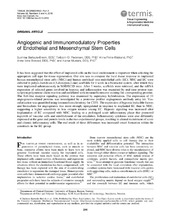| dc.contributor.author | Bartaula-Brevik, Sushma | en_US |
| dc.contributor.author | Pedersen, Torbjørn Østvik | en_US |
| dc.contributor.author | Finne-Wistrand, Anna | en_US |
| dc.contributor.author | Bolstad, Anne Isine | en_US |
| dc.contributor.author | Mustafa, Kamal Babikeir Eln | en_US |
| dc.date.accessioned | 2016-12-16T10:35:29Z | |
| dc.date.available | 2016-12-16T10:35:29Z | |
| dc.date.issued | 2016-02 | |
| dc.identifier.issn | 1937-335X | |
| dc.identifier.uri | https://hdl.handle.net/1956/15250 | |
| dc.description.abstract | It has been suggested that the effect of implanted cells on the local environment is important when selecting the appropriate cell type for tissue regeneration. Our aim was to compare the local tissue response to implanted human mesenchymal stem cells (MSC) and human umbilical vein endothelial cells (EC). MSC and EC were cultured in poly(l-lactide-co-1,5-dioxepan-2-one) scaffolds for 1 week in a bioreactor system, after which they were implanted subcutaneously in NOD/SCID mice. After 3 weeks, scaffolds were retrieved, and the mRNA expression of selected genes involved in hypoxia and inflammation was examined by real-time reverse transcription polymerase chain reaction and correlated with immunofluorescent staining for corresponding proteins. The Toll-like receptor signaling pathway was examined by superarray hybridization. The expression of 53 angiogenesis-related proteins was investigated by a proteome profiler angiogenesis antibody array kit. Vascularization was quantified using immunohistochemistry for CD31. The expression of hypoxia-inducible factors and biomarkers for angiogenesis was more strongly upregulated in response to implanted EC than to MSC, suggesting a higher sensitivity to low oxygen tension among EC. Hypoxic signaling was increased after implantation of EC compared with MSC, leading to a prolonged acute inflammatory phase that promoted ingrowth of vascular cells and establishment of the circulation. Inflammatory cytokines were also differently expressed at the gene and protein levels in the two experimental groups, resulting in altered recruitment of acute and chronic inflammatory cells. The end result of these differences was increased vessel formation within the constructs in the EC group. | en_US |
| dc.language.iso | eng | eng |
| dc.publisher | Mary Ann Liebert | eng |
| dc.rights | Attribution CC BY-NC | eng |
| dc.rights.uri | http://creativecommons.org/licenses/by-nc/4.0/ | eng |
| dc.title | Angiogenic and Immunomodulatory Properties of Endothelial and Mesenchymal Stem Cells | en_US |
| dc.type | Peer reviewed | |
| dc.type | Journal article | |
| dc.date.updated | 2016-11-04T08:47:43Z | |
| dc.description.version | publishedVersion | en_US |
| dc.rights.holder | Copyright 2016 The Author(s) | |
| dc.identifier.doi | https://doi.org/10.1089/ten.tea.2015.0316 | |
| dc.identifier.cristin | 1390000 | |
| dc.source.journal | Tissue Engineering. Part A | |
| dc.source.pagenumber | 244-252 | |
| dc.identifier.citation | Tissue Engineering. Part A 2016, 22(3-4):244-252 | |
| dc.source.volume | 22 | |
| dc.source.issue | 3-4 | |

